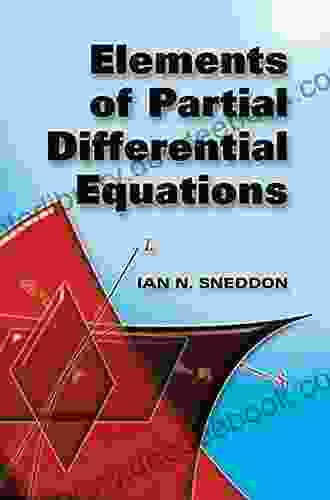Elements of Partial Differential Equations: A Comprehensive Guide

Partial differential equations (PDEs) are a powerful mathematical tool used to model a vast array of complex physical phenomena. From the flow of fluids to the propagation of waves, PDEs have become indispensable in various scientific and engineering disciplines. The study of PDEs involves a deep understanding of their mathematical properties, analytical techniques, and applications in real-world problems.
This article aims to provide a comprehensive overview of the fundamental concepts, analytical methods, and applications of PDEs, with a particular focus on the seminal work of Dover on Mathematics. We will delve into the history, theoretical foundations, and practical significance of PDEs, equipping readers with a solid understanding of this essential branch of mathematics.
The origins of PDEs can be traced back to the seventeenth century, when scientists began to explore the mathematical framework for describing the behavior of continuous physical systems. Isaac Newton and Gottfried Leibniz independently developed the calculus of variations, which provided a foundation for formulating and solving PDEs.
4.5 out of 5
| Language | : | English |
| File size | : | 25109 KB |
| Text-to-Speech | : | Enabled |
| Screen Reader | : | Supported |
| Enhanced typesetting | : | Enabled |
| Print length | : | 352 pages |
| Lending | : | Enabled |
In the eighteenth century, Leonhard Euler and Jean le Rond d'Alembert made significant contributions to the theory of PDEs, particularly in the context of fluid mechanics and wave propagation. Their work laid the groundwork for the systematic study of PDEs and their applications in various scientific fields.
The nineteenth century witnessed a surge in the development of PDE theory, with mathematicians like Joseph-Louis Lagrange, Pierre-Simon Laplace, and Carl Friedrich Gauss making notable advancements. The concept of the Green's function was introduced, providing a powerful tool for solving boundary value problems.
Partial differential equations can be classified into various types based on their order, linearity, and the number of independent variables involved. Some of the most common types of PDEs include:
- First-order equations: These equations involve first derivatives of the dependent variable with respect to the independent variables. They are often used to model transport phenomena, such as heat conduction or diffusion.
- Second-order equations: These equations involve second derivatives of the dependent variable. They are commonly encountered in applications involving wave propagation, elastic vibrations, and fluid flow.
- Linear equations: Linear equations have coefficients that are constant or functions of the independent variables only. They exhibit the property of superposition, which simplifies their analysis.
- Nonlinear equations: Nonlinear equations have coefficients that depend on the dependent variable or its derivatives. They are more complex to solve than linear equations and often require numerical methods.
Solving PDEs analytically involves various techniques, each tailored to specific types of equations and boundary conditions. Some widely used analytical methods include:
- Method of separation of variables: This method assumes that the solution to the PDE can be expressed as a product of functions of each independent variable. It is commonly used for solving PDEs with constant coefficients.
- Fourier series and transforms: Fourier analysis provides a framework for representing functions as a sum of trigonometric functions. It is used to solve PDEs involving periodic or oscillatory solutions.
- Green's functions: Green's functions are solutions to PDEs with specific boundary conditions. They can be used to represent the solution to a general PDE by integrating over the Green's function.
- Numerical methods: When analytical methods fail, numerical techniques like finite difference methods or finite element methods can be used to approximate the solution to PDEs.
PDEs have found widespread applications in various scientific and engineering disciplines, including:
- Fluid mechanics: PDEs are used to model fluid flow, including incompressible flow, compressible flow, and turbulence.
- Heat transfer: PDEs govern heat conduction, convection, and radiation. They are used to design heat exchangers, analyze thermal systems, and predict temperature distributions.
- Wave propagation: PDEs describe the propagation of waves in various media, including electromagnetic waves, acoustic waves, and seismic waves.
- Structural mechanics: PDEs are used to analyze the behavior of structures under various loads, including stress, strain, and deformation.
- Computational science: PDEs are used in numerical simulations to model complex physical systems, such as weather forecasting, climate modeling, and drug discovery.
Dover on Mathematics is a renowned publisher specializing in books on mathematics and science. Over the years, Dover has published numerous influential works on partial differential equations, including:
- ** to Partial Differential Equations with Numerical Methods** by Donald W. Trim
- Applied Partial Differential Equations by Richard Haberman
- **Partial Differential Equations: A Modern ** by Dean G. Duffy
- Partial Differential Equations and Solitary Waves by Peter D. Lax
These books provide comprehensive s to PDE theory, numerical methods, and applications in various fields. They have become essential resources for students, researchers, and professionals alike.
Partial differential equations are a fundamental tool for understanding and modeling a wide range of physical phenomena. Their study involves a deep exploration of mathematical concepts, analytical techniques, and practical applications. The work of Dover on Mathematics has played a significant role in advancing the field of PDEs and making it accessible to a broad audience.
By mastering the concepts and techniques of PDEs, scientists and engineers gain the ability to tackle complex problems in various disciplines. PDEs continue to be at the forefront of research and innovation, enabling breakthroughs in areas such as computational modeling, materials science, and artificial intelligence.
As we continue to explore the intricate world of partial differential equations, we can expect to uncover further insights into the fundamental workings of our universe. The legacy of Dover on Mathematics will continue to inspire generations of mathematicians and scientists to delve deeper into this fascinating field.
4.5 out of 5
| Language | : | English |
| File size | : | 25109 KB |
| Text-to-Speech | : | Enabled |
| Screen Reader | : | Supported |
| Enhanced typesetting | : | Enabled |
| Print length | : | 352 pages |
| Lending | : | Enabled |
Do you want to contribute by writing guest posts on this blog?
Please contact us and send us a resume of previous articles that you have written.
 Book
Book Page
Page Text
Text Genre
Genre E-book
E-book Newspaper
Newspaper Paragraph
Paragraph Bookmark
Bookmark Shelf
Shelf Glossary
Glossary Bibliography
Bibliography Foreword
Foreword Manuscript
Manuscript Scroll
Scroll Codex
Codex Tome
Tome Bestseller
Bestseller Classics
Classics Narrative
Narrative Biography
Biography Dictionary
Dictionary Thesaurus
Thesaurus Character
Character Resolution
Resolution Card Catalog
Card Catalog Stacks
Stacks Research
Research Scholarly
Scholarly Lending
Lending Academic
Academic Rare Books
Rare Books Special Collections
Special Collections Interlibrary
Interlibrary Study Group
Study Group Thesis
Thesis Dissertation
Dissertation Storytelling
Storytelling Reading List
Reading List Book Club
Book Club Textbooks
Textbooks Kate Stayman London
Kate Stayman London Hiromi Uehara
Hiromi Uehara Gumdrop Press
Gumdrop Press Paul Brown
Paul Brown Gianno Caldwell
Gianno Caldwell Bethany Stutsman
Bethany Stutsman Gary W Burnett
Gary W Burnett Dave Courvoisier
Dave Courvoisier Reynolds
Reynolds Arne Fronsdal
Arne Fronsdal Sue Beeton
Sue Beeton Jack Finney
Jack Finney Felicia Harper
Felicia Harper Saul Bellow
Saul Bellow Beth Oberholtzer
Beth Oberholtzer Katharine E Smith
Katharine E Smith Mike Pinfold
Mike Pinfold Robert I Katz
Robert I Katz Lois Walfrid Johnson
Lois Walfrid Johnson Yellow Light
Yellow Light
Light bulbAdvertise smarter! Our strategic ad space ensures maximum exposure. Reserve your spot today!

 Jorge AmadoFrankenstein Student Edition Novel Learning Series: An In-Depth Exploration...
Jorge AmadoFrankenstein Student Edition Novel Learning Series: An In-Depth Exploration... Jacob FosterFollow ·4.8k
Jacob FosterFollow ·4.8k Derrick HughesFollow ·8.9k
Derrick HughesFollow ·8.9k Rob FosterFollow ·6.6k
Rob FosterFollow ·6.6k Elias MitchellFollow ·2.5k
Elias MitchellFollow ·2.5k Michael CrichtonFollow ·19.7k
Michael CrichtonFollow ·19.7k Emanuel BellFollow ·11k
Emanuel BellFollow ·11k Gustavo CoxFollow ·3.4k
Gustavo CoxFollow ·3.4k Ron BlairFollow ·16.2k
Ron BlairFollow ·16.2k

 Bo Cox
Bo CoxDiscover the Enchanting Allure of Collingwood, Ontario,...
Nestled amidst the breathtaking landscape of...

 Ralph Ellison
Ralph EllisonThe Street of Clocks Poems: A Poetic Journey Through Time
Welcome to The Street...

 Dwight Blair
Dwight BlairCritical Political Economy of the Middle East and North...
The Middle East and...

 Deion Simmons
Deion SimmonsPerfect Strategies For Painting Amazing Marine Creatures...
Gouache is a...

 Hugh Bell
Hugh BellThe American Republic: Constitution, Tendencies, and...
The American Republic,...
4.5 out of 5
| Language | : | English |
| File size | : | 25109 KB |
| Text-to-Speech | : | Enabled |
| Screen Reader | : | Supported |
| Enhanced typesetting | : | Enabled |
| Print length | : | 352 pages |
| Lending | : | Enabled |












